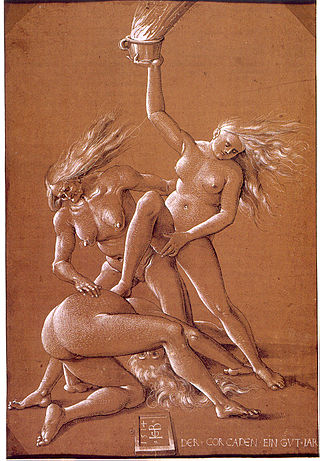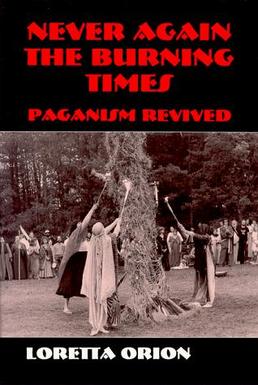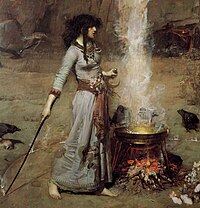
Dianic Wicca, also known as Dianic Witchcraft, is a modern pagan goddess tradition focused on female experience and empowerment. Leadership is by women, who may be ordained as priestesses, or in less formal groups that function as collectives. While some adherents identify as Wiccan, it differs from most traditions of Wicca in that only goddesses are honored.

Wicca, also known as The Craft, is a modern neo-pagan syncretic religion. Scholars of religion categorize it as both a new religious movement and as part of occultist Western esotericism. It was developed in England during the first half of the 20th century and was introduced to the public in 1954 by Gerald Gardner, a retired British civil servant. Wicca draws upon a diverse set of ancient pagan and 20th-century hermetic motifs for its theological structure and ritual practices.

Starhawk is an American feminist and author. She is known as a theorist of feminist neopaganism and ecofeminism. In 2013, she was listed in Watkins' Mind Body Spirit magazine as one of the 100 Most Spiritually Influential Living People.

Zsuzsanna Emese Mokcsay is an American writer, activist, playwright and songwriter living in America who writes about feminist spirituality and Dianic Wicca under the pen name Zsuzsanna Budapest or Z. Budapest. She is the founder of the Susan B. Anthony Coven #1, which was founded in 1971 as the first women-only witches' coven. She founded the female-only type of Dianic Wicca.
The Triple Goddess is a deity or deity archetype revered in many Neopagan religious and spiritual traditions. In common Neopagan usage, the Triple Goddess is viewed as a triunity of three distinct aspects or figures united in one being. These three figures are often described as the Maiden, the Mother, and the Crone, each of which symbolizes both a separate stage in the female life cycle and a phase of the Moon, and often rules one of the realms of heavens, earth, and underworld. In various forms of Wicca, her masculine consort is the Horned God.

The Goddess movement includes spiritual beliefs or practices that emerged predominantly in North America, Western Europe, Australia, and New Zealand in the 1970s. The movement grew as a reaction to Abrahamic religions, which have only gods with whom are referred by male pronouns, and it uses goddess worship and may include a focus on women or on one or more understandings of gender or femininity.

Drawing Down the Moon: Witches, Druids, Goddess-Worshippers, and Other Pagans in America Today is a sociological study of contemporary Paganism in the United States written by the American Wiccan and journalist Margot Adler. First published in 1979 by Viking Press, it was later republished in a revised and expanded edition by Beacon Press in 1986, with third and fourth revised editions being brought out by Penguin Books in 1996 and then 2006 respectively.

W.I.T.C.H., originally the acronym for Women's International Terrorist Conspiracy from Hell, was the name of several related but independent feminist groups active in the United States as part of the women's liberation movement during the late 1960s. The W.I.T.C.H. moniker was sometimes alternatively expanded as "Women Inspired to Tell their Collective History", or "Women Interested in Toppling Consumer Holidays", among other variations.
Reclaiming is a tradition in neopagan witchcraft, aiming to combine the Goddess movement with feminism and political activism. Reclaiming was founded in 1979, in the context of the Reclaiming Collective (1978–1997), by two Neopagan women of Jewish descent, Starhawk and Diane Baker, in order to explore and develop feminist Neopagan emancipatory rituals.

European witchcraft is a multifaceted historical and cultural phenomenon that unfolded over centuries, leaving a mark on the continent's social, religious, and legal landscapes. The roots of European witchcraft trace back to classical antiquity when concepts of magic and the supernatural were interwoven into societal beliefs. Ancient Rome, then a pagan society, had laws against harmful magic. During the Middle Ages, misogynist views of women led to the association of women and malevolent witchcraft, as accusations of heresy and devil worship grew more prevalent. By the early modern period, major witch hunts began to take place, partly fueled by religious tensions, societal anxieties, and economic upheaval. Witches were viewed as dangerous sorceresses or sorcerers in a pact with the Devil, capable of causing harm through black magic.
The history of Wicca documents the rise of the Neopagan religion of Wicca and related witchcraft-based Neopagan religions. Wicca originated in the early 20th century, when it developed amongst secretive covens in England who were basing their religious beliefs and practices upon what they read of the historical witch-cult in the works of such writers as Margaret Murray. It also is based on the beliefs from the magic that Gerald Gardner saw when he was in India. It was subsequently founded in the 1950s by Gardner, who claimed to have been initiated into the Craft – as Wicca is often known – by the New Forest coven in 1939. Gardner's form of Wicca, the Gardnerian tradition, was spread by both him and his followers like the High Priestesses Doreen Valiente, Patricia Crowther and Eleanor Bone into other parts of the British Isles, and also into other, predominantly English-speaking, countries across the world. In the 1960s, new figures arose in Britain who popularized their own forms of the religion, including Robert Cochrane, Sybil Leek and Alex Sanders, and organizations began to be formed to propagate it, such as the Witchcraft Research Association. It was during this decade that the faith was transported to the United States, where it was further adapted into new traditions such as Feri, 1734 and Dianic Wicca in the ensuing decades, and where organizations such as the Covenant of the Goddess were formed.

Wiccan views of divinity are generally theistic, and revolve around a Goddess and a Horned God, thereby being generally dualistic. In traditional Wicca, as expressed in the writings of Gerald Gardner and Doreen Valiente, the emphasis is on the theme of divine gender polarity, and the God and Goddess are regarded as equal and opposite divine cosmic forces. In some newer forms of Wicca, such as feminist or Dianic Wicca, the Goddess is given primacy or even exclusivity. In some forms of traditional witchcraft that share a similar duotheistic theology, the Horned God is given precedence over the Goddess.
Modern paganism in the United States is represented by widely different movements and organizations. The largest modern pagan religious movement is Wicca, followed by Neodruidism. Both of these religions or spiritual paths were introduced during the 1950s and 1960s from Great Britain. Germanic Neopaganism and Kemetism appeared in the US in the early 1970s. Hellenic Neopaganism appeared in the 1990s.

Neopagan witchcraft, sometimes referred to as The Craft, is an umbrella term for some neo-pagan traditions that include the attempted practice of magic. These traditions began in the mid-20th century and were influenced by the witch-cult hypothesis, a now-rejected theory that persecuted witches in Europe had actually been followers of a surviving pagan religion. Traditions classed as neopagan witchcraft include Wicca and the various movements that describe themselves as "Traditional Witchcraft".
Semitic neopaganism is a group of religions based on or attempting to reconstruct the ancient Semitic religions, mostly practiced among Jews in the United States.

A Community of Witches: Contemporary Neo-Paganism and Witchcraft in the United States is a sociological study of the Wiccan and wider Pagan community in the Northeastern United States. It was written by American sociologist Helen A. Berger of the West Chester University of Pennsylvania and first published in 1999 by the University of South Carolina Press. It was released as a part of a series of academic books entitled Studies in Comparative Religion, edited by Frederick M. Denny, a religious studies scholar at the University of Chicago.

Enchanted Feminism: The Reclaiming Witches of San Francisco is an anthropological study of the Reclaiming Wiccan community of San Francisco. It was written by the Scandinavian theologian Jone Salomonsen of the California State University, Northridge and first published in 2002 by the Routledge.

Never Again the Burning Times: Paganism Revisited is an anthropological study of the Wiccan and wider Pagan community in the United States. It was written by the American anthropologist Loretta Orion and published by Waveland Press in 1995.

Living Witchcraft: A Contemporary American Coven is a sociological study of an American coven of Wiccans who operated in Atlanta, Georgia during the early 1990s. It was co-written by the sociologist Allen Scarboro, psychologist Nancy Campbell and literary critic Shirley Stave and first published by Praeger in 1994. Although largely sociological, the study was interdisciplinary, and included both insider and outsider perspectives into the coven; Stave was an initiate and a practicing Wiccan while Scarboro and Campbell remained non-initiates throughout the course of their research.

Modern paganviews on LGBT people vary considerably among different paths, sects, and belief systems. LGBT individuals comprise a much larger percentage of the population in neopagan circles than larger, mainstream religious populations. There are some popular neopagan traditions which have beliefs often in conflict with the LGBT community, and there are also traditions accepting of, created by, or led by LGBT individuals. The majority of conflicts concern heteronormativity and cisnormativity.














